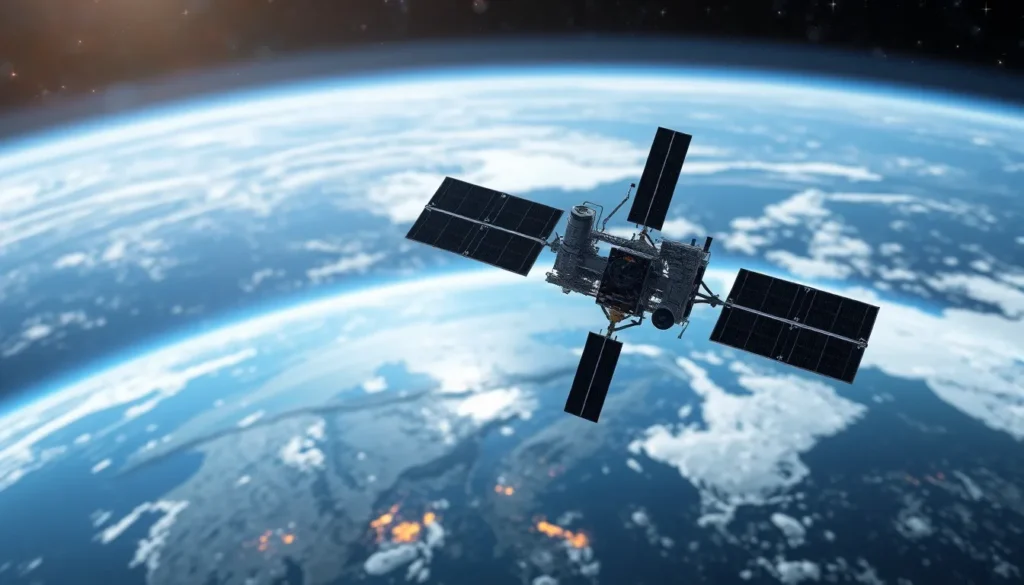Table of Contents
ToggleIn the vast expanse of space, where the stars twinkle like diamonds and mysteries abound, one technology stands out as the ultimate detective: electromagnetic spectrum technology. This remarkable tool doesn’t just sit around looking pretty; it actively gathers vital information about our universe, from the fiery surface of distant stars to the icy rings of Saturn.
Understanding the Electromagnetic Spectrum
The electromagnetic spectrum encompasses all forms of electromagnetic radiation. Each type varies in wavelength and frequency, from radio waves to gamma rays.
Definition and Range
Electromagnetic spectrum refers to a range of wavelengths that include various types of radiation. These include radio waves, microwaves, infrared, visible light, ultraviolet, X-rays, and gamma rays. Each type serves unique purposes in various applications. For instance, radio waves excel at communication, while X-rays specialize in medical imaging. The spectrum’s range spans approximately 0.1 nanometers to over 100 kilometers. Understanding this range helps scientists and engineers effectively utilize each type of radiation for different technological advancements.
Importance in Space Technology
Utilization of the electromagnetic spectrum is essential in space technology. Satellites depend on various wavelengths for data collection and observation. Telescopes employ visible light and infrared to study celestial bodies, revealing details about their compositions and movements. Observations made with radio waves contribute to understanding cosmic phenomena such as pulsars and cosmic microwave background radiation. Every type of radiation plays a significant role in gathering information, which aids in advancing knowledge about the universe. Thus, mastery of the electromagnetic spectrum proves crucial for successful exploration and research in space.
Types of Space Technology Utilizing the Electromagnetic Spectrum

Space technology harnesses the electromagnetic spectrum for various applications. This spectrum facilitates effective data collection essential for understanding the universe.
Remote Sensing Satellites
Remote sensing satellites utilize visible light, infrared, and microwave wavelengths. These satellites capture images of Earth’s surface, providing crucial data for agriculture, land use, and climate monitoring. Sensors on these satellites detect changes in vegetation, temperature, and surface water, helping scientists analyze environmental conditions. Notably, the Landsat satellites have provided continuous data since the 1970s, offering valuable insights into changing landscapes.
Communication Satellites
Communication satellites use microwaves and radio waves to transmit signals across vast distances. These technologies support global communication networks, enabling telephone calls, television broadcasts, and internet services. Frequencies in the Ku-band and C-band are commonly utilized for these transmissions, ensuring reliable communication methods. The efficiency of these satellites relies on their ability to capture and relay data transmitted through the electromagnetic spectrum, connecting millions of users worldwide.
Scientific Instruments on Space Probes
Scientific instruments on space probes operate across various wavelengths, including ultraviolet, X-ray, and gamma-ray. These instruments gather data from distant celestial bodies, expanding knowledge about their composition and behavior. For instance, the Hubble Space Telescope captures high-resolution images in visible and ultraviolet light, revealing intricate details of galaxies and stars. Instruments aboard the Mars rovers, such as spectrometers, analyze the Martian surface using infrared wavelengths, searching for signs of past water and potential life.
Applications of Electromagnetic Spectrum in Space
The electromagnetic spectrum plays a vital role in various space applications. It enables the collection of essential data across multiple disciplines.
Earth Observation and Monitoring
Remote sensing satellites utilize visible light, infrared, and microwave wavelengths. These technologies capture detailed images of Earth’s surface. Vital data for sectors like agriculture comes from these observations. Climate monitoring also benefits significantly, with satellites identifying changes in environmental patterns. Enhanced imaging techniques allow for assessing land use and natural resources efficiently.
Astronomy and Space Exploration
Astronomy relies heavily on the electromagnetic spectrum for exploring celestial bodies. Telescopes and space probes operate across wavelengths such as ultraviolet, X-ray, and gamma-ray. The Hubble Space Telescope gathers high-resolution images, revealing intricate details of distant galaxies. Mars rovers analyze Martian terrain for signs of hydration and potential life. Unique data from various wavelengths leads to groundbreaking discoveries in astrophysics and planetary science.
Future Developments in Space Technology
Exploring future advancements in space technology reveals exciting prospects in utilizing the electromagnetic spectrum. Innovations aim to enhance data collection methods and improve overall efficiency in space missions.
Advancements in Signal Processing
Advancements in signal processing techniques significantly improve the ability to interpret data from satellites and telescopes. Machine learning algorithms optimize data analysis, enabling real-time processing of vast datasets. Enhanced filtering methods minimize noise, ensuring clearer signals from distant celestial objects. These developments contribute to increased accuracy in measurements and observations, aiding researchers in their exploration efforts. Techniques such as adaptive algorithms allow communication satellites to adjust frequencies dynamically, maintaining reliable connections across varying distances. Additionally, improved data compression techniques facilitate efficient storage and transmission of complex information gathered from various electromagnetic wavelengths.
Enhanced Sensing Capacities
Enhanced sensing capacities represent one of the most promising areas of growth in space technology. Remote sensing satellites increasingly utilize advanced sensors operating across diverse wavelengths, including infrared and microwave. These advancements enable more precise observations of atmospheric conditions, land use changes, and natural disaster events. Enhanced sensor capabilities improve spatial resolution, allowing scientists to analyze finer details of Earth’s surface. Furthermore, they expand the range of detectable phenomena, including subtle changes in ecosystems. Ultra-sensitive instruments on space probes also enhance the capacity to capture emissions from distant stars, providing invaluable insights into their composition and behavior. As these innovations progress, researchers gain unprecedented access to previously unreachable data, revolutionizing our understanding of the universe.
The utilization of the electromagnetic spectrum in space technology is a game changer for exploration and research. By harnessing different wavelengths, scientists and engineers can gather critical data that enhances our understanding of celestial bodies and phenomena. From remote sensing satellites monitoring Earth to telescopes uncovering the mysteries of the universe, the applications are vast and varied.
Future advancements promise even greater capabilities in data collection and analysis. As technology continues to evolve, the potential for groundbreaking discoveries remains limitless. The electromagnetic spectrum will undoubtedly play a pivotal role in shaping the future of space exploration and expanding humanity’s knowledge of the cosmos.




